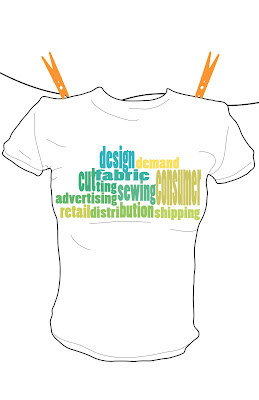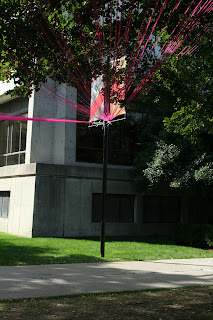Drama, stress, anticipation. It’s 3:30 on Monday 10.05.09. The set is in disarray. People are running everywhere frantically. The fabric panels are ripping off the fence. Our class is really worried that the extremely windy weather is literally going to sweep all of our hard work away. Finally we decided to puncture holes into the panels; which alleviated the strong wind tension in them. All the while Professor Phil Comeau is blasting techno beats into the quad.
04:15- Lighting and videographer crew arrives. They immediately begin running wires everywhere and angling lighting onto the runway. Pink film is attached to the lights.
04:30- The installation of the set is finished. The string panels are pulled out from the fence. The spatial environment is finally complete. We all hurry into Waston Auditorium to get our models ready.
The Master of Architecture Design Studio’s goal was to locate a neglected space on our campus that could become livened with our open-air installation. We wanted to enrich this ignored space and transform it into an atmosphere that could not be imagined to exist there. We selected the barren volleyball court adjacent to the tennis courts after scrutinizing different sites thoroughly. Our studio chose to use limited amounts of everyday materials to enliven the limited site, yet used them with innovation: neon pink string became canopies and panels, white cardboard boxes morphed into projection screens, and hot pink fabric strips transformed into screens and partitions. Two-Fold relates to how all of these materials link and connect to each other. The intersection point results in a fold or kink in the material. All of the materials fold out from one plane and onto another.
05:00- One hour until show time. Our backstage in Watson is extremely chaotic as models are fitted, primped, and stylized. Everyone is laughing, animated, and ecstatic to see each other’s outfits. The photographer Jeff McMullin photographs every model and his or her contrasting or complementing pair.
05:15- Fabric, coffee filters, plates, feathers, flowers, safety blankets, candy, playing cards, pool noodles, trash bags, paper, forks…EVERYWHERE! 05:45- Frantic. 06:00- All of the models are finally lined up in the correct order. There is a buzz of excitement and anxiousness in the air.
06:11- Shows on! I lead the models outside, snapping photos as models clamor down the stairs. The doors fling open…Professor Phil Comeau yells to the crowd “Are you ready for the long awaited event?! I can’t hear you!” The first two models are nervous and keep asking me how they should walk down the runway.
06:12- Erik Polyzou and Amanda Cabey-Strout take off down the runway…the crowd goes wild! Erik dips Amanda in the center of the runway and the show takes off.
Once the models hit the stage, the lights and music were on, and the crowd was cheering; the space became alive. The event was successful because of the relationship of all these components. The show was better than I could have ever anticipated. 8 rows deep of spectators were surrounding the runway. All of the professors, students, and friends were really getting into the show and feeding off the enthusiasm of the crowd. Models were chest bumping, dancing, shimmying, twirling, and strutting with each other. I could not believe how beautiful the light was hitting the canopy, how excited the crowd was, and how well the models were strutting and interacting with the crowd.
06:23- Melissa Martinez twirls down the runway in a voluminous coffee filter dress.
06:32- Professor Justin Humphreys dances down the runway in a robot-esk garment constructed of paper.
06:43- Professor Robert Cowherd break dances in front of the crowd in a Frank Gehry reminiscent insulation suit. Followed by Professor Rob Trumbor swishing down the runway in a purple pom-pom ensemble.
06:55- The final two models are up. Professor Glen Wiggins, the architecture department head, struts down the aisle in a very shiny “emergency blanket” suit and enormous hot pink bow tie, followed by our studio Professor Beth Gibb in a lovely voluminous “paper wedding dress”. Professor Phil Comeau, our incredible DJ, plays the wedding march on the piano as Gibb makes her way down the runway, reminiscence of many professional runway shows. After Wiggins and her meet at the end stage, the crowd goes wild, Comeau blasts the music, and the 10 of us in charge come running out. It was fun to be part of the runway and the show. The models follow us and a dance party ensues.
I never realized how much of a connection fashion and architecture have with one another. Both professions begin designing in the same way: sketching, photoshopping, researching, and collecting inspirational images. Each begins with two-dimensional materials and develops an envelope in which people interact in or with.
It was fun to design, build, budget, and resolve real issues in the studio environment. In the typical studio situation, we design a building or space and never have the opportunity to see if our design works or not. In this studio exercise we were able to work with each other, test various sites around campus, develop a design, test it to see if it worked, resolve issues, and publicize and organize the event. I hope that the Masters program continues creating annual architecture affairs because our class has shown that through design, we can unite studios, professors, students, and the school with each other.
-alexandra dupnik








































